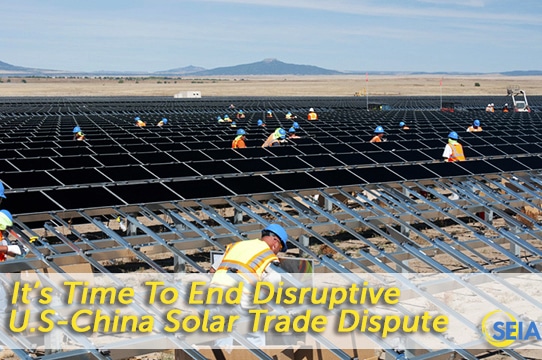It’s Time To End Disruptive U.S-China Solar Trade Dispute
Monday, Sep 23 2013

Trade disputes often have a nasty way of becoming trade wars.
With no end in sight to the ongoing solar dispute between the United States and China – and tensions now escalating – the Solar Energy Industries Association (SEIA) today offered an industry compromise designed to end the standoff. We believe our proposal could serve as the centerpiece for a fair, negotiated settlement of all outstanding issues, benefit end users, and encourage the proliferation of solar energy in the United States and globally.
Our proposed settlement represents a way out of this trade quagmire. It would, first and foremost, address the ongoing competitiveness issues between U.S. and Chinese solar cell and module manufacturers by effectively monetizing the U.S. antidumping and countervailing duty orders. To date, these orders have provided little benefit to U.S. solar manufacturers. In turn, Chinese manufacturers and American consumers would benefit from reduced costs. The proposal would also restore U.S. polysilicon manufacturers’ ability to compete in the Chinese market, remedying an “innocent bystander” problem.
For months, SEIA has been working behind the scenes in Washington and Beijing to resolve the current conflict and head off an escalation of trade sanctions. SEIA has warned U.S. negotiators that any settlement similar to the recently-announced EU-China agreement would represent a blow to the U.S. solar industry because of an expected increase in solar prices. SEIA also believes that any resolution of the U.S.-China solar dispute must recognize the interests of all stakeholders, including American consumers, and not just one segment of the industry.
Here are the highlights of our proposal:
- Chinese companies would agree to create a fund that would benefit U.S. solar manufacturers directly and help to grow the U.S. market. Money for the fund would come from a percentage of the price premium Chinese companies are currently paying to third-country cell producers to get around U.S. trade sanctions, reducing costs and supply chain distortion for Chinese companies.
- The Chinese government would also agree to end its antidumping and countervailing duty investigations on U.S. polysilicon exports to China and remove the threat of artificial cost increases in a key raw material in the solar value chain, benefiting not just Chinese solar companies but all users of solar energy.
- In return, the U.S. antidumping and countervailing duties orders would be phased out.
- The proposal also calls for a safeguard mechanism designed to offset any surge of Chinese solar modules into the U.S. market.
A key provision of the settlement calls for the establishment of the Solar Development Institute, which would be funded by Chinese manufacturers. The Institute, in turn, would focus its resources on expanding the U.S. solar market for all participants and growing the U.S. solar manufacturing base.
The Institute would also serve as the primary vehicle for fostering long-term collaboration between the U.S. and Chinese solar industries, including joint research and development projects as well as collaboration on environment, health, safety and codes and standards initiatives.
As an additional step, we also believe the U.S. government should take all steps necessary to ensure that federal procurement opportunities are provided to domestic solar manufacturers in recognition of the importance of U.S. solar manufacturing to the nation’s long-term energy security.
SEIA’s proposal is based on a precedent set during a 2002 trade dispute between the U.S. and Brazil over allegations of unfair American subsidies on cotton. The World Trade Organization (WTO) eventually ruled against the United States and – as part of the settlement – a fund was established to compensate Brazilian farmers. Today, the U.S. pays about $150 million a year to Brazil’s cotton industry to avoid being punished by the WTO.
Even though negotiations to resolve the U.S.-China solar trade dispute are continuing in earnest, the discussions appear to be focused right now on a minimum price and/or quotas. This is absolutely the wrong approach. Any settlement which includes these components would represent a significant step backwards for both the U.S. solar industry and the solar industry globally.
Simply put, SEIA’s proposal represents a fair, balanced approach to ending a very costly, 2-year-old trade dispute, which is now threatening to escalate. If that happens, there will be no winners – only degrees of losers and a missed opportunity that may not present itself again.
Rhone Resch, SEIA President and CEO